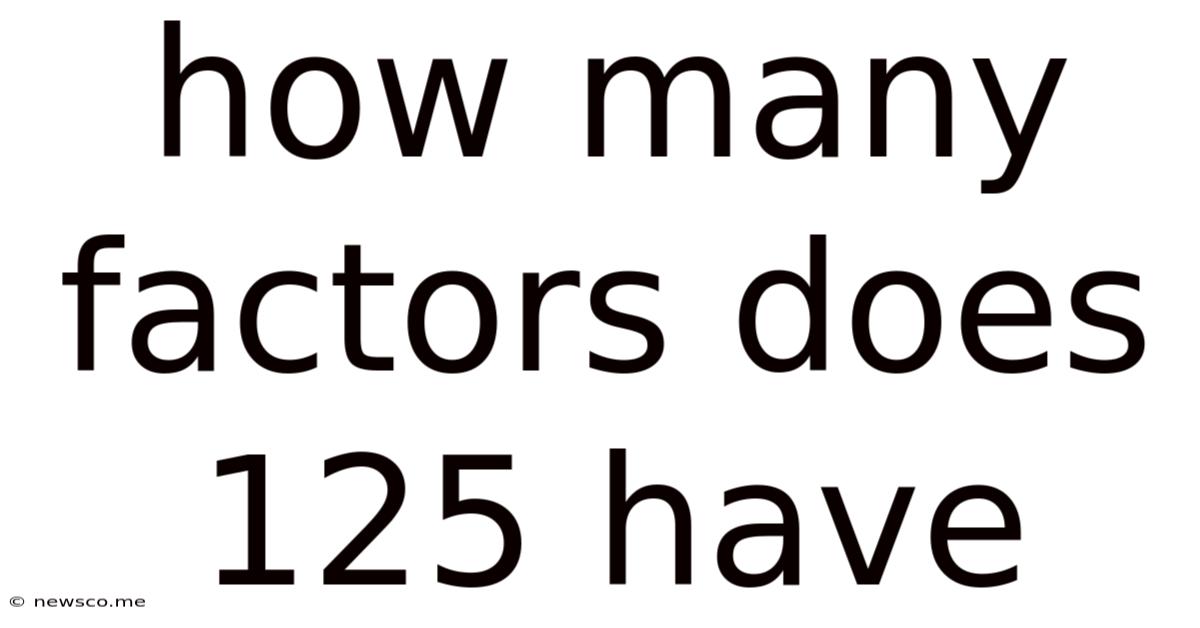How Many Factors Does 125 Have
News Co
Apr 19, 2025 · 4 min read

Table of Contents
How Many Factors Does 125 Have? A Deep Dive into Prime Factorization and Divisibility
Finding the number of factors for a given integer might seem like a simple mathematical task, but it unveils a fascinating world of prime factorization and divisibility rules. Let's explore how to determine the number of factors of 125, and delve into the broader concepts that underpin this seemingly straightforward problem.
Understanding Factors and Divisors
Before we tackle the specific case of 125, let's define our key terms. Factors, also known as divisors, are whole numbers that divide another number without leaving a remainder. For instance, the factors of 12 are 1, 2, 3, 4, 6, and 12. Each of these numbers divides 12 evenly.
Prime Factorization: The Key to Finding Factors
The most efficient way to find all the factors of a number is through prime factorization. Prime factorization is the process of expressing a number as a product of its prime factors. A prime number is a whole number greater than 1 that has only two divisors: 1 and itself (e.g., 2, 3, 5, 7, 11, etc.).
Let's find the prime factorization of 125:
125 is divisible by 5: 125 = 5 x 25 25 is also divisible by 5: 25 = 5 x 5
Therefore, the prime factorization of 125 is 5 x 5 x 5, or 5³.
From Prime Factorization to the Number of Factors
The prime factorization provides the key to determining the total number of factors. Here's the method:
-
Identify the prime factors and their exponents: In the prime factorization of 125 (5³), we have one prime factor, 5, with an exponent of 3.
-
Add 1 to each exponent: Add 1 to the exponent of each prime factor: 3 + 1 = 4
-
Multiply the results: Multiply the numbers obtained in step 2. In this case, there's only one number, 4, so the answer is 4.
Therefore, 125 has four factors.
Listing the Factors of 125
Let's verify this by listing all the factors of 125:
- 1: 1 x 125 = 125
- 5: 5 x 25 = 125
- 25: 25 x 5 = 125
- 125: 125 x 1 = 125
We have successfully identified all four factors: 1, 5, 25, and 125. This confirms our calculation using prime factorization.
Extending the Concept to Other Numbers
Let's apply this method to a few more examples to solidify our understanding:
Example 1: Finding the factors of 36
- Prime factorization of 36: 2² x 3²
- Add 1 to each exponent: (2+1) x (2+1) = 3 x 3 = 9
- 36 has 9 factors: 1, 2, 3, 4, 6, 9, 12, 18, 36
Example 2: Finding the factors of 72
- Prime factorization of 72: 2³ x 3²
- Add 1 to each exponent: (3+1) x (2+1) = 4 x 3 = 12
- 72 has 12 factors.
Example 3: A Number with More Prime Factors
Let's consider the number 720:
- Prime factorization of 720: 2⁴ x 3² x 5¹
- Add 1 to each exponent: (4+1) x (2+1) x (1+1) = 5 x 3 x 2 = 30
- 720 has 30 factors.
This demonstrates the power and efficiency of using prime factorization to determine the number of factors, especially for larger numbers. Manually listing factors becomes impractical for numbers with numerous factors.
Understanding the Mathematical Logic
The reason this method works stems from the fundamental theorem of arithmetic, which states that every integer greater than 1 can be uniquely represented as a product of prime numbers. By considering the exponents in the prime factorization, we account for all possible combinations of prime factors that result in divisors of the original number. Adding 1 to each exponent accounts for the inclusion or exclusion of each prime factor in the formation of a divisor.
Applications Beyond Simple Factor Counting
The concept of prime factorization and the number of factors has far-reaching applications beyond simple mathematical exercises:
-
Cryptography: Prime factorization is fundamental to many modern encryption methods. The difficulty of factoring large numbers into their prime components forms the basis of the security of these systems.
-
Number Theory: The study of factors and divisors is a core component of number theory, a branch of mathematics dealing with the properties of integers.
-
Computer Science: Algorithms related to prime factorization and divisibility are used extensively in computer science for tasks like optimization and data structure management.
Conclusion: The Elegance of Prime Factorization
Determining the number of factors of 125, and more generally, any integer, highlights the elegance and power of prime factorization. This seemingly simple mathematical concept unlocks a deeper understanding of number theory and its widespread applications in various fields. By mastering this technique, you gain a valuable tool for solving mathematical problems and appreciating the underlying structure of numbers. Remember, understanding prime factorization not only helps in finding the factors but also unlocks a broader understanding of the world of numbers.
Latest Posts
Related Post
Thank you for visiting our website which covers about How Many Factors Does 125 Have . We hope the information provided has been useful to you. Feel free to contact us if you have any questions or need further assistance. See you next time and don't miss to bookmark.